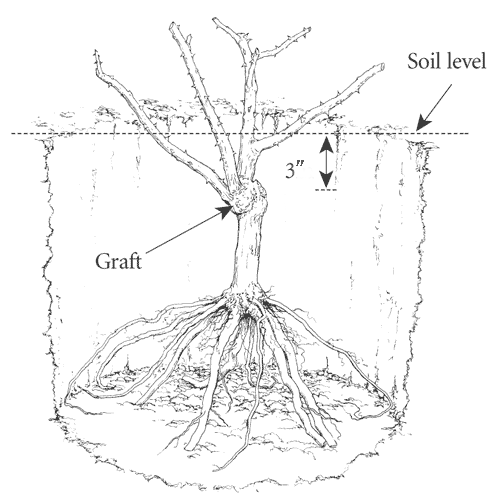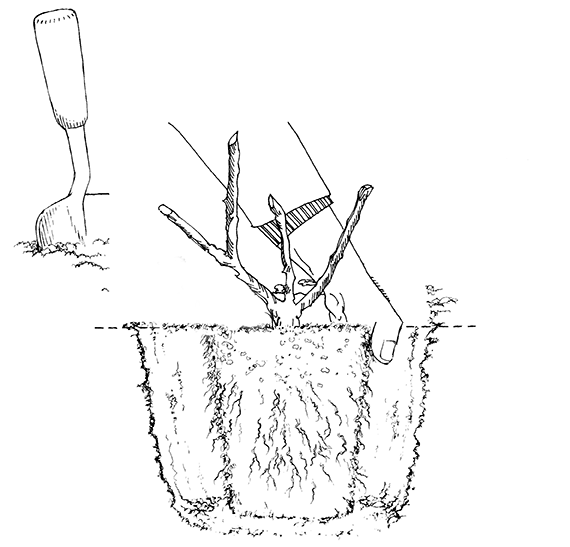How to grow Roses
Latin Name Pronunciation: roe'zuh
Today's Roses are easier to grow than you might expect.
- The basic needs for Roses include plenty of direct sun,6 hours or more, and fertile, well-drained soil.
- Roses tolerate a range of soil types (from sand to clay), as long as a little care is taken to prepare the soil at planting time.
We offer both own-root and grafted Roses.
- Own-root Roses are plants grown from cuttings. They have their own root systems and remain true to the original varieties.
- Grafted Roses are plants that have vigorous rootstocks fused to the top parts of other Roses that are valued for their flowers.
Planting Bareroot Roses:
- Before planting a bareroot Rose, remove and discard the packing material and soak the roots for a few hours.
- Dig a planting hole that allows sufficient room for the depth and spread of the roots.
- Add organic matter—such as compost or aged manure—and mix this into the soil dug from the hole.
- Set the plant in the hole so that the top of the graft, or the crown of own-root Roses (the point where the stems of the plant meet the roots), is 3" below soil level in the North, and at the same level or 1" above where winters are mild.

- Push the mix of soil and organic matter back into the hole, tamping firmly as you go. Water thoroughly.
- Add a generous layer of organic mulch (compost or aged manure is best) to help keep the soil evenly moist.
- Water thoroughly once every 2 weeks if rainfall is scarce throughout the growing season and into fall.
Planting Potted Roses:
- Check the moisture of the potting mix in the container and, if dry, water thoroughly.
- Dig a hole wide enough and just deep enough for the root ball.
- Add organic matter—such as compost or aged manure—and mix this into the soil dug from the hole.
- Remove the plant from the container and gently break up the sides of the root ball with your thumbs and carefully untangle any roots circling at the bottom.
- Set the root ball in the hole so that the top of the root ball is level with the surface of the surrounding soil.

- Push the mix of soil and organic matter back into the hole, tamping firmly as you go. Water thoroughly.
- Add a generous layer of organic mulch (compost or aged manure is best) to help keep the soil evenly moist.
- Water thoroughly once a week if rainfall is scarce during the growing season and throughout fall.
Rose Care
Best time to plant Roses: Roses are best planted in spring or fall when mild temperatures encourage the plants to develop root systems. We ship Roses for both spring and fall planting with our broadest selection available in spring. To ensure successful planting of any type of Rose, simply follow the easy guidelines laid out in our Grow Guides, which can be found on our website, on the product page for each Rose variety. The guidelines include light requirements, optimal soil conditions, ideal planting depth, and Rose Care tips to include watering, pruning, end-of-season care, and more. We do not recommend planting Roses in summer because the season’s high temperatures can stress the plants, urging them to push growth above ground before they have had sufficient time to establish supportive root systems.
Light: Roses grow best where they receive at least 6 hours of direct sun per day.
Watering: We recommend watering in the morning if possible so that the foliage doesn’t remain wet into the evening. If the weather is dry, water thoroughly every 2 weeks.
Fertilizer: Roses grow more vigorously, bloom more prolifically, and show greater resistance to diseases if fertilized during the growing season.
- For best results, add a layer of compost or aged manure in early spring around the base of the plant. After the first wave of bloom, apply a bloom-boosting fertilizer (15-30-15).
- For organic gardeners, we recommend adding a layer of compost or aged manure in early spring and applying an organic fertilizer after the first wave of bloom.
Pests & Diseases: The Roses we offer are selected for their vigor and their resistance to pests and diseases.
- Some Roses are prone to fungus problems (such as black spot) in hot, humid areas. Cleaning up old foliage from the base of the plant is important for disease control.
- We recommend the use of environmentally-friendly horticultural oil and insect sprays listed by the Organic Materials Review Institute (OMRI).
- Japanese beetles may be handpicked or a systemic pesticide may be used. In spring, check for Rose slugs (sawfly larvae that appear as tiny, green caterpillars and skeletonize Rose foliage) and physically destroy them or spray with superfine horticultural oil.
Pruning: Prune Roses to remove deadwood, to control or direct growth, and to promote flowering.
- Wait until growth breaks from the canes in early to mid-spring before pruning.
- To train climbers in early spring, trim thinner side shoots from the base of the main branches. Attach new stems to their supports throughout the growing season.
- If the Rose bush has become too tall, the stems may be cut back by one-third to one-half in early spring or after the first wave of blooms.
- With the exception of the rugosas, which produce attractive hips (fruits), remove the spent flowers of reblooming Roses to promote more bloom.
Transplanting: Roses may be moved in early spring when dormant.
End-of-Season Care: In our experience, the best way to get Roses through winter is to choose plants adapted to your climate zone.
- Mound 2 shovelfuls of bark mulch around the base of the plant before the start of winter. This added layer of protection is especially important for grafted Roses.


